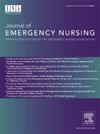Measurement of Patient-Level Outcomes After Implementation of Trauma-Informed Care Training in the Emergency Department: A Pilot Study
IF 1.8
4区 医学
Q2 EMERGENCY MEDICINE
引用次数: 0
Abstract
Introduction
Trauma-informed care has been posited as a framework to optimize patient care and engagement, but there is a paucity of data on patient-level outcomes after trauma-informed care training in health care settings. We sought to measure patient-level outcomes after a painful procedure after implementation of trauma-informed care training for ED staff.
Methods
As part of a quality improvement initiative, we trained 110 ED providers in trauma-informed care. Next, we prospectively recruited patients who had undergone a painful procedure to complete a survey to assess several patient-level outcomes, such as anxiety reduction and overall experience of care. We compared differences in patient outcomes for those who were treated by providers in the trauma-informed care intervention group with those who were treated by providers who did not complete the training (usual care).
Results
One-hundred forty-seven adult patients completed survey measures (n = 76 trauma-informed care intervention group; n = 71 usual care group) over a 1-month period. Most patients offered the highest rating for all ED staff-related questions. We found no significant differences in assessment of patient-reported outcomes based on intervention versus usual care.
Discussion
Our trauma-informed care training did not seem to have a significant effect on our selected patient outcomes. This may be caused by the training itself or the challenges in measurement of the patient-level impact of trauma-informed care training owing to the study design, setting, and lack of standardized tools. Recommendations for future study of trauma-informed care training and measuring its direct impact on patients in the ED setting are discussed.
在急诊科实施创伤知情护理培训后对患者层面结果的测量:试点研究。
导言:创伤知情护理被认为是优化患者护理和参与的一个框架,但在医疗机构开展创伤知情护理培训后,患者层面的治疗效果却鲜有数据。我们试图测量急诊室员工接受创伤知情护理培训后,患者在疼痛手术后的治疗效果:作为质量改进计划的一部分,我们对 110 名急诊室医护人员进行了创伤知情护理培训。接下来,我们对接受过疼痛手术的患者进行了前瞻性招募,让他们完成一项调查,以评估患者层面的几种结果,如焦虑减轻程度和整体护理体验。我们比较了接受创伤知情护理干预组治疗的患者与接受未完成培训的医疗服务提供者(常规护理)治疗的患者在治疗效果上的差异:147 名成年患者完成了为期 1 个月的调查(n = 76 名创伤知情护理干预组患者;n = 71 名常规护理组患者)。大多数患者对所有与急诊室工作人员相关的问题都给予了最高评价。我们发现,干预与常规护理对患者报告结果的评估没有明显差异:讨论:我们的创伤知情护理培训似乎并未对选定的患者结果产生显著影响。这可能是培训本身造成的,也可能是由于研究设计、环境和标准化工具的缺乏,在衡量创伤知情护理培训对患者的影响方面存在挑战。本文讨论了对创伤知情护理培训的未来研究以及衡量其对急诊室环境中患者的直接影响的建议。
本文章由计算机程序翻译,如有差异,请以英文原文为准。
求助全文
约1分钟内获得全文
求助全文
来源期刊
CiteScore
3.10
自引率
11.80%
发文量
132
审稿时长
46 days
期刊介绍:
The Journal of Emergency Nursing, the official journal of the Emergency Nurses Association (ENA), is committed to the dissemination of high quality, peer-reviewed manuscripts relevant to all areas of emergency nursing practice across the lifespan. Journal content includes clinical topics, integrative or systematic literature reviews, research, and practice improvement initiatives that provide emergency nurses globally with implications for translation of new knowledge into practice.
The Journal also includes focused sections such as case studies, pharmacology/toxicology, injury prevention, trauma, triage, quality and safety, pediatrics and geriatrics.
The Journal aims to mirror the goal of ENA to promote: community, governance and leadership, knowledge, quality and safety, and advocacy.

 求助内容:
求助内容: 应助结果提醒方式:
应助结果提醒方式:


